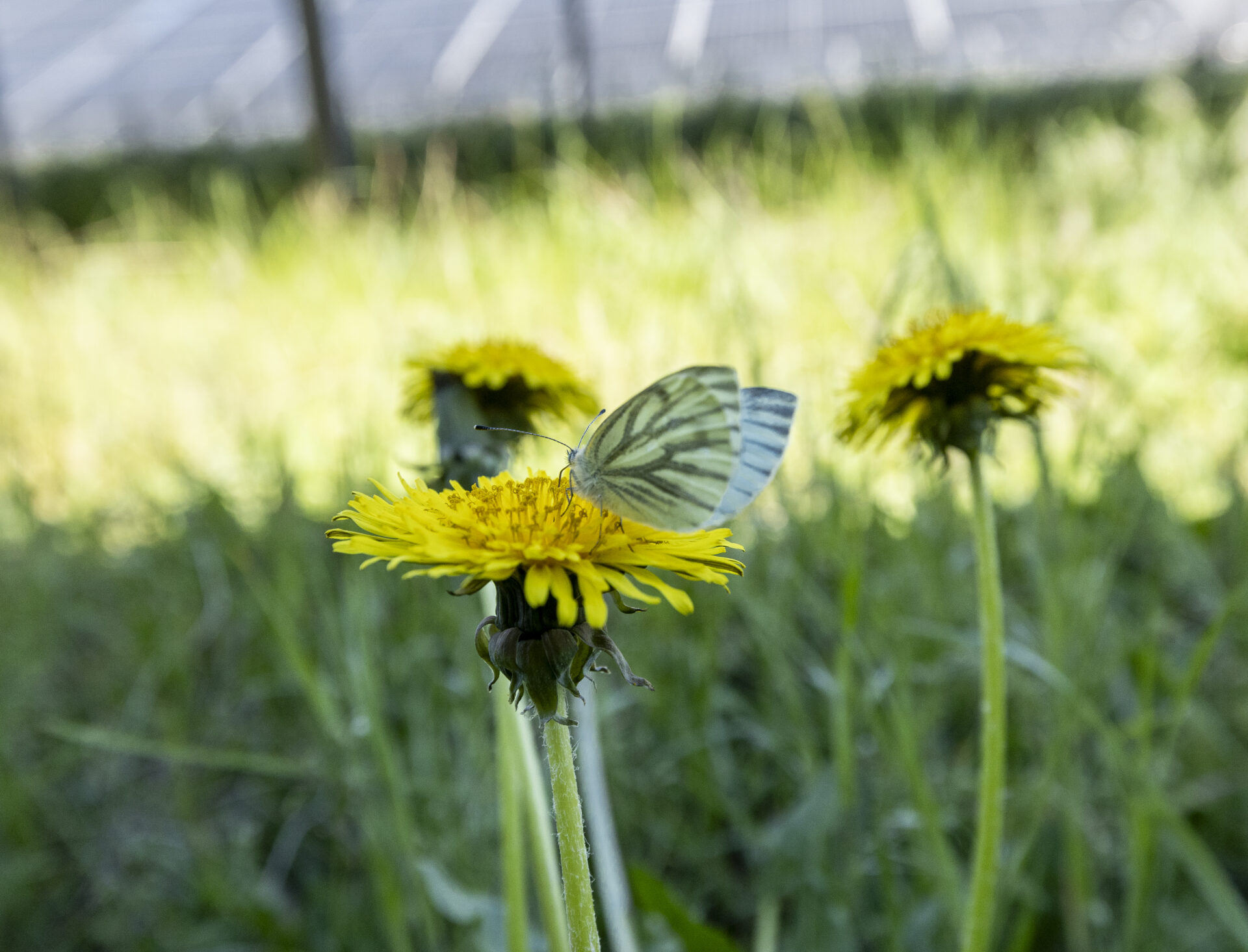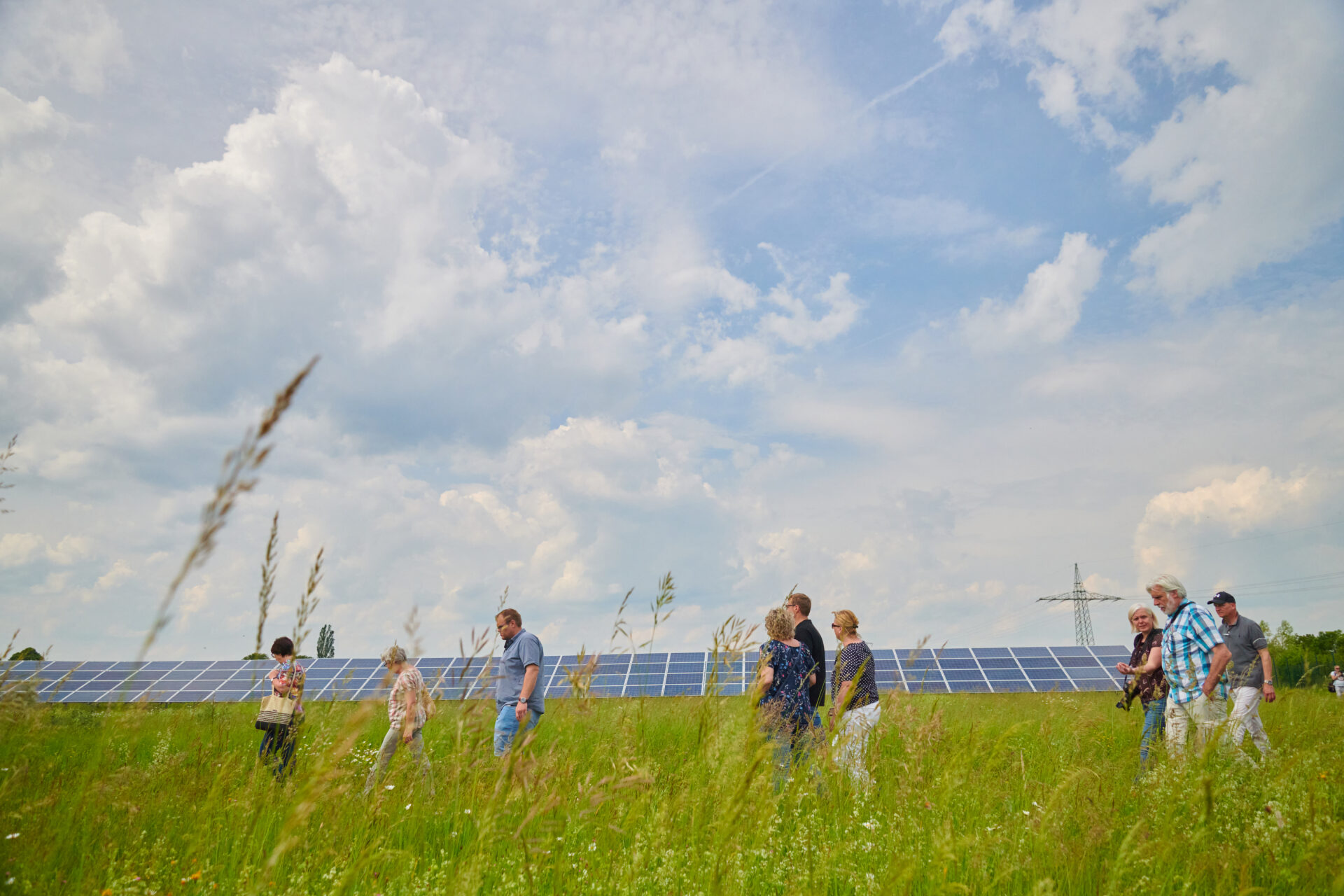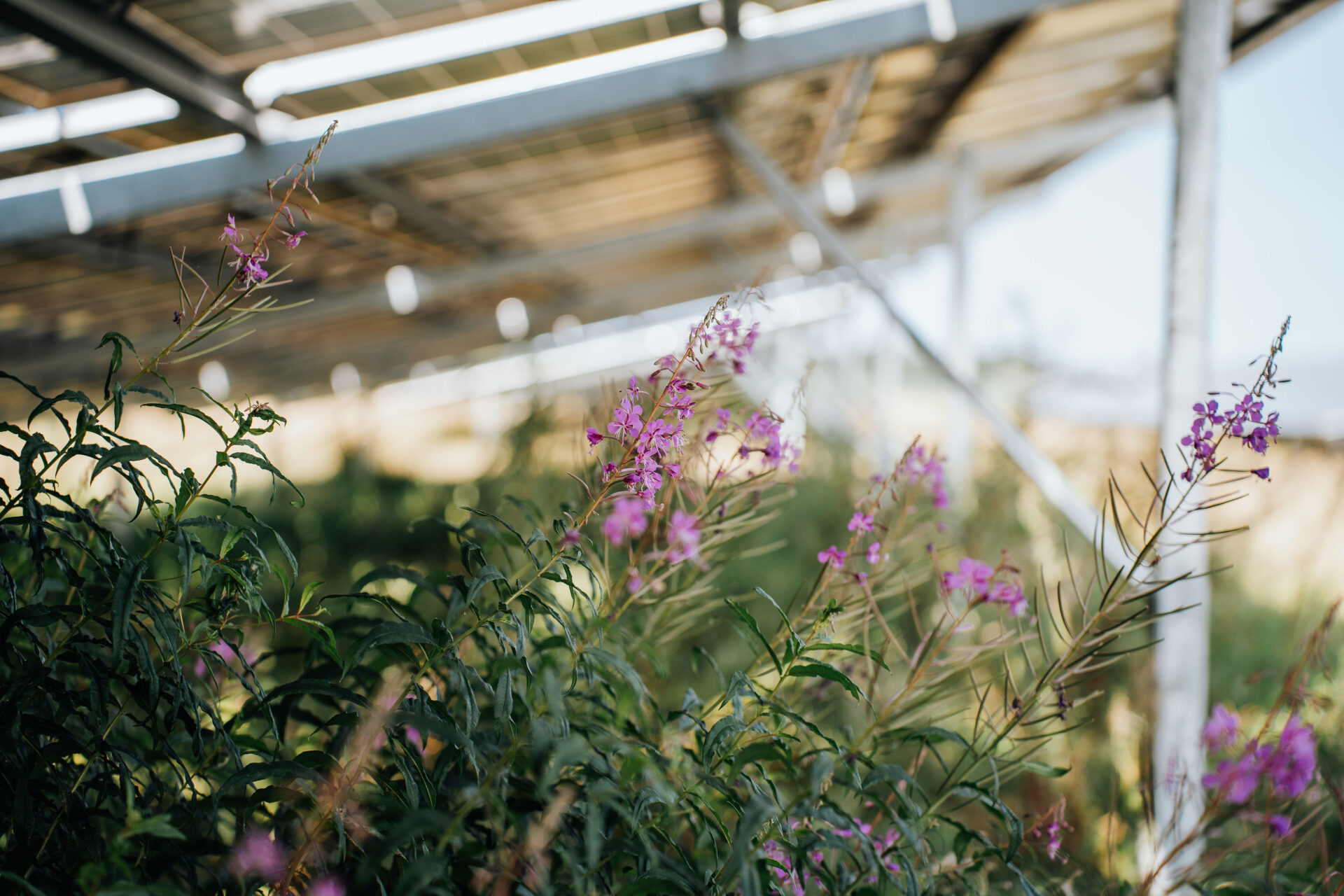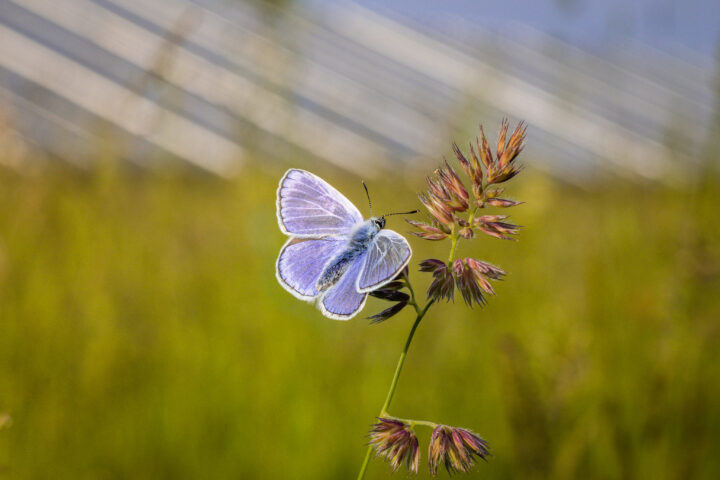In solar parks, a Variety of different insects on the road - this has already been proven by many research reports and studies such as "Biodiversity in solar parks - a nationwide field study" shown. But how much biomass of flying insects is actually present in the solar park, and How do solar park areas differ? e.g. from neighbouring nature conservation areas in terms of insect density? These and other questions are Jennifer Rix in their Master thesis followed up. They analysed various areas inside and outside a solar park by means of a AI-supported automated monitoring system. We asked her a few questions about this research work.
Scope, methodology & results
Scope of the investigations - period and arean
Results of the survey of flying insect activity
Influence of birds and sheep grazing
Which insect species occur due to sheep grazing?
Area-specific differences
Further information
Presentation of the AI-supported solution for monitoring
Challenges in data collection and analysis

1. how did you come across the topic of insect detection in solar parks and what particularly interested you about it?
I studied landscape planning and nature conservation in my Bachelor's degree and environmental protection in my Master's degree, and the topics of climate crisis and biodiversity loss have been with me the whole time. During my studies, the decline of insects was also a recurring theme - although the exact quantity is still largely unknown. During my Master's degree, I worked as a student trainee in the nature and species conservation team at EnBW, which gave me my first experience of solar park issues. I was particularly interested in the potential of new measurement techniques for recording insects in order to expand this knowledge and be able to map the situation in solar parks.
2. please briefly describe the scope of the surveys - during which period were insects recorded in which areas?
The master's thesis is a quantitative data collection with subsequent hypothesis testing. The investigations included the recording of flying insects in the Weesow-Willmersdorf solar park using FaunaPhotonics measuring devices. A total of six devices were used at different locations inside and outside the park. The measurement period lasted seven months, and I analysed the data from the first two and a half months as part of my master's thesis. Two measuring devices were placed at central locations in the solar park, one at the edge, one in the wildlife corridor between the central module areas, one on an adjacent field and one in the neighbouring FFH area "Weesower Luch". The devices automatically provide real-time information on daily activity, total activity, biomass and a biodiversity index for each location.

3. can you briefly explain how you studied the insects in the solar parks and what methods you used?
The flying insects were analysed using special, solar-powered measuring devices from FaunaPhotonics. Each device has a sensor on a tripod that emits infrared light via LED modules and makes flying insects detectable for the sensor above. The activities of the flying insects were automatically recorded during the day and AI-supported compared with information from a database (including physical characteristics and wing beat frequencies of different flying insect species) so that it was later possible to analyse activities, biomass and the biodiversity index. The biodiversity index was not presented at species level, but showed how many different individuals were travelling around a sensor. The measurements began in mid-April and the data was analysed for the master's thesis by the end of June.
4. what results did you find when recording flying insect activity in solar parks? Were there any differences between the individual sites?
Three questions were analysed as part of the Master's thesis.
To the first questionhow the locations differ from each other overall: It was noticeable that, contrary to expectations, the highest insect activity and biomass was measured on the rapeseed field, followed by the central areas of the solar park, the wildlife corridor, the Weesower Luch and the edge of the solar park. Biodiversity showed values between 0.6 and 0.8 (range 0-1), but increased slightly over the measurement period. At the beginning, the highest values were seen in the FFH area; towards the end of the measurements, the values at the solar park sites overtook them. The values of the arable field site were usually somewhat less biodiverse than the edge site. It was surprising that despite intensive cultivation (including the repeated use of insecticides), the rapeseed field showed such high activity values that they even overtook the FFH area - presumably this was due to the fact that the site was located at a distance of around ten metres from the edge of the field in the vicinity of a field copse, which is generally conducive to insects. It is also assumed that many individuals of fewer insect species were attracted by the main flowering period of the oilseed rape. Unfortunately, it was not possible to identify the species present, but it is known, for example, that the March fly, which occurs in oilseed rape sacks, mates in flight and occurs in swarms. In combination with the alignment of the measuring device and the limited setting height of the sensor, this may have led to the results obtained. It was also interesting to observe that the central areas of the solar parks showed the next highest levels of activity and that the grazing situation on site appears to have a positive influence on the occurrence of flying insects.
The second questionThe comparison of central and peripheral areas of the solar park showed that activity and biomass were higher in the centre of the park than at the edge, although there were slight differences between the sites.
The third questionvalidation of the measurement technology compared to "traditionally" used recording methods: positive experiences have been made with the handling of the measuring devices and the availability of data in real time. The use of the devices allows personnel resources to be saved. Unfortunately, the technology used could not provide any information on the species present. This information is essential for the visualisation of biodiversity in relation to insect species. The mapping of biomass and thus available food for insectivorous animals was nevertheless a valuable result. The results from the arable site were questionable and should be considered in conjunction with classic mapping and other reference sites.
5. is there a connection or how reliable is the connection between a high occurrence of birds in Weesow-Wilmersdorf and a lower occurrence of insects?
This topic is dealt with in the Master's thesis. There are several possible reasons for the differences in the occurrence of flying insects. It is important to categorise where the sensors were set up - for example, no measurements were taken under the modules. More investigations and reference areas would be necessary to make reliable statements. The results so far are only a random sample. During the breeding season, predation pressure from birds such as starlings and skylarks is very high, which may have influenced the results of the flying insect surveys at the various locations. As an open land bird, the skylark generally avoids dense and tall-growing structures such as rape fields or field hedges, which is why the search for food at the arable site during the selected study period from shortly before flowering until harvest is unlikely.
6. which insect species occur due to sheep grazing?
According to literature research, fly species in particular, but also butterflies, bees and bumblebees occur in the solar park as a result of grazing. These pollinating flying insects are mainly found where flowers are present. Fly species cluster around the sheep's droppings, for example. It was observed that the flying insect activity and the resulting available biomass moved with the grazing, as the activity also changed at the sites after the sheep herd was moved. As the activity correlated positively with the grazing, the sheep appear to have a stronger influence than the flowering shark.

7. how does biodiversity in solar parks differ from that on traditional agricultural land or in nature reserves?
The study only covered a short measurement period, whereby FaunaPhotonics recommends at least one, but preferably up to three years for recording biodiversity. In addition, only flying insects were recorded - the representation of the biodiversity of an area is, however, a complex issue. In principle, cleared arable landscapes that are intensively farmed are considered less biodiverse than well-planned and realised solar parks. However, targeted planning on suitable areas, well-thought-out site maintenance in terms of nature conservation, the avoidance of pesticides and fertilisers and consideration of individual site conditions are important for enhancement.
8. what role does the diurnal activity of the insects play in your study? Have you observed any particular patterns?
As the measuring devices were powered by solar energy, they only provided results during the day. As temperatures rose, the peaks in insect activity shifted - at the beginning there were peaks at midday and in the evening, later in the year more at the end of the day. The greatest activity was measured in May.
9. which technical systems or AI-supported solutions have you used for monitoring and how do they work?
This question is already partially answered in question 2. The data recorded in the database was analysed with the help of AI using FaunaPhotonics. A wide range of information on the behaviour and physical characteristics of different species is stored here. The insect flying through the light field is recognised by the sensor. This is followed by a comparison of factors such as body proportions and wing beat frequency. AI-supported analyses are used to determine when and how many different individuals were detected in front of the sensor and what biomass and heterogeneity is depicted around the sensor. As part of my master's thesis, I used this data to analyse the raw data and subsequently test hypotheses.

10. what challenges did you face when collecting and analysing the data?
The results from the rapeseed field site were methodologically challenging as the sensors were closer to the flowers than at other sites due to the growth height of the rapeseed. In general, the detailed methodological planning must be very well thought out in order to ensure the comparability of the sites and to be able to make valid statements. For future studies, more reference sites, longer study intervals and parallel mapping would be useful.
11. what significance do you think solar park areas have for nature conservation and the promotion of biodiversity?
Solar parks offer huge potential for nature and species conservation, especially if they are built on suitable areas. The mandatory fencing of solar parks creates a calm space and measures such as the use of regional seeds and native trees and shrubs, the implementation of extensive cultivation without the use of fertilisers and pesticides and a well thought-out park layout (row spacing and ground clearance) can promote biodiversity. Solar parks can thus serve as stepping stone habitats in which species can recover and develop.

12. what other findings emerged from the subsequent measurements that were no longer included in the Master's thesis?
After completing the master's thesis, it became apparent that insect activity and biomass in the solar park had tended to decrease. In September, there was an increase in activity in the FFH area, while there were strong fluctuations in the field that were difficult to explain. At the end of the measurements, the biodiversity index showed the greatest biodiversity in the wildlife corridor, followed by the FFH area, the peripheral site and the central solar park sites.
13. what further research questions arise from your work and how could research in this area continue?
There are many exciting research questions, particularly regarding the further development of measurement technology, species identification and investigations in different solar parks. Long-term studies and before-and-after comparisons would be particularly interesting, but are not currently planned.
14. do you deal with similar topics in your current job at EnBW as in your Master's thesis?
Yes, as a nature and species conservation manager at EnBW, I am still involved in nature and species conservation issues. I support projects during project development in the areas of onshore wind and PV, and accompany the various project development steps with regard to nature and species conservation issues. Co-operation with expert offices is an integral part of my work. Other tasks include supporting research projects.
Alice Brüssel-Kurbanov conducted the interview with Jennifer Rix, Nature and Species Conservation Manager at EnBW AG, on 12 June 2020. The complete master's thesis can be downloaded viewed here become.






